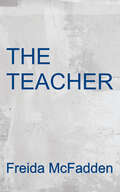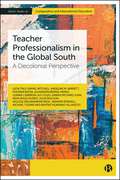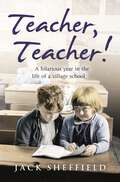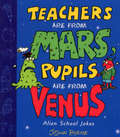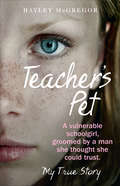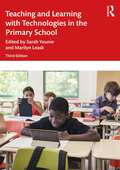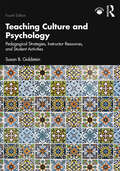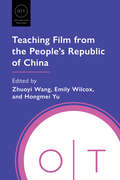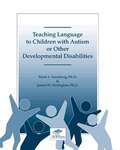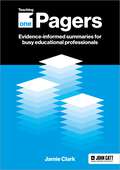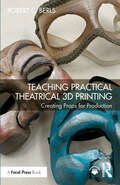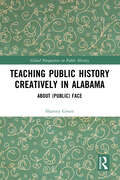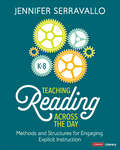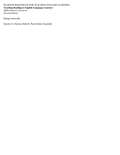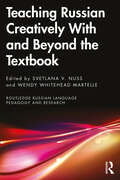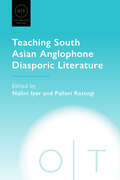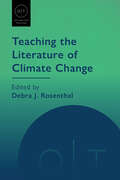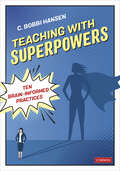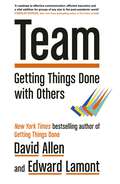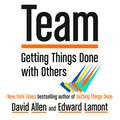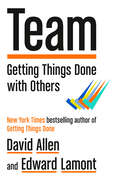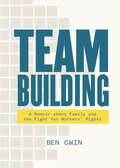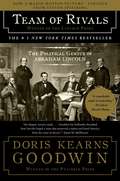- Table View
- List View
The Teacher
by Freida McFaddenEve has a good life. She wakes up each day, kisses her husband Nate, and heads off to teach math at the local high school. All is as it should be. Except… Last year, Caseham High was rocked by a scandal involving a student-teacher affair, with one student, Addie, at its center. But Eve knows there is far more to these ugly rumors than meets the eye. Addie can’t be trusted. She lies. She hurts people. She destroys lives. At least, that’s what everyone says. But nobody knows the real Addie. Nobody knows the secrets that could destroy her. And Addie will do anything to keep it quiet… From the New York Times bestselling author Freida McFadden comes a chilling story of twisted secrets and long-awaited revenge.
Teacher Professionalism in the Global South: A Decolonial Perspective (Bristol Studies in Comparative and International Education)
by Leon Tikly Rafael Mitchell Angeline M. Barrett Poonam Batra Alexandra Bernal Leanne Cameron Alf Coles Zawadi Richard Juma Nidia Aviles Nunez Julia Paulson Nigusse Weldemariam Reda Jennifer Rowsell Michael Tusiime Beatriz VejaranoThis book provides a decolonial critique of dominant global agendas concerning teacher professionalism and proposes a new understanding based on UNESCO-funded research with teachers based in Colombia, Ethiopia (Tigray), India, Rwanda and Tanzania. Outlining from a teacher’s perspective how teacher professionalism may be conceptualized, this book critiques dominant global narratives and conceptions based on deficit discourses. The authors argue that a decolonial lens can help to contextualize the perspectives, experiences and material conditions of teachers in the global South, and the value of such a framework for informing global debates and decision-making in education.
Teacher, Teacher!
by Jack SheffieldIt's 1977 and Jack Sheffield is appointed headmaster of a small village primary school in North Yorkshire. So begins Jack's eventful journey through the school year and his attempts to overcome the many problems that face him as a young and inexperienced headmaster.The many colourful chapters include Ruby the 20 stone caretaker with an acute spelling problem, a secretary who worships Margaret Thatcher, a villager who grows giant carrots, a barmaid/parent who requests sex lessons, and a five-year-old boy whose language is colourful in the extreme. And then there's also beautiful, bright Beth Henderson, who is irresistibly attractive to the young headmaster...Warm, funny and nostalgic, Teacher, Teacher is a delightful read that is guaranteed to make you feel better, whatever kind of day you've had.
Teachers Are From Mars, Pupils Are From Venus : School Joke Book
by John ByrneAs you've probably realised, kids and teachers are two entirely different species. Why do teachers behave so oddly? Because they're from a different planet, that's why! But remember, they think the odd things you do are just as funny! And in this little book the jokes are on everyone - so prepare for classroom chaos!
Teacher's Pet
by Hayley McGregor‘He manipulated me by making me feel special … then duped me into thinking I was to blame.’ Hayley was just 12 when she met Mr Willson, the new drama teacher at her school. Good looking and charismatic, he was classic schoolgirl-crush material. Hayley was flattered by the attention he gave her, and he soon befriended her parents. Little did they know they were all being groomed. Hayley allowed Mr Willson to do unspeakable things to her, and after the relationship ended it took almost 20 years of guilt and crippling self-esteem issues before a complete breakdown prompted her to tell her parents, and they went with her to the police. This is the shocking true story of a schoolgirl groomed by her teacher, and her courageous journey to heal the wrongs of her past.
Teaching and Learning with Technologies in the Primary School
by Marilyn Leask Sarah YounieThis fully updated third edition of Teaching and Learning with Technologies in the Primary School introduces practising and student teachers to the range of ways in which technology can be used to support and extend teaching and learning opportunities in their classrooms.Newly expanded to include 50% brand new chapters reflecting the abundant changes in the field since the last edition was published, it offers practical guidance underpinned by the latest research and teaching in the field. The authors draw on the extensive experience of educators in Australia, England, Ireland, Scotland, South Africa, the U.S.A. and Wales to provide local, national and international examples of the application of digital technologies to teaching and learning across the primary curriculum.Illustrated throughout with case studies and examples together with a glossary explaining key terms, chapters focus on how technology-based practices can support the teaching of individual subjects, as well as a range of teaching and learning styles. Key and new topics covered include:- Supporting reading and writing with technology- Technology in the early years- Developing e-skills of parents- Use of Virtual Reality in learning- PedTech- Resilience in the digital worldWritten for all training primary teachers, as well as more experienced teachers and technology co-ordinators looking for guidance on the latest innovative practice, Teaching and Learning with Technologies in the Primary School, 3rd edition, offers advice and ideas for creative, engaging and successful teaching and learning.
Teaching Culture and Psychology: Pedagogical Strategies, Instructor Resources, and Student Activities
by Susan B. GoldsteinThe fourth edition of Teaching Culture and Psychology (previously Cross-Cultural Explorations) provides an array of carefully designed instructor resources and student activities that support the construction and implementation of courses on culture and psychology.Revised and expanded from previous editions, the book enables instructors to use selected activities appropriate for their course structure. Part One explores a variety of pedagogical challenges involved in teaching about culture and psychology and details specific strategies for addressing these challenges. Part Two (instructor resources) and Part Three (student handouts) center around 90 activities designed to encourage students to think critically about the role of culture in a wide range of psychology content areas. These activities are based on current and classic cross-cultural research and take the form of case studies, self-administered scales, mini-experiments, database search assignments, and the collection of content-analytic, observational, and interview data. For each activity, instructors are provided with a lecture/discussion module as well as suggestions for variations and expanded writing assignments. Student handouts are available in this text as well as on the Routledge website as fillable forms.Contributing to the inclusion of cultural perspectives in the psychology curriculum, this wide-ranging book enables instructors to provide students with hands-on experiences that facilitate the understanding and application of major concepts and principles in the study of culture and psychology, making it ideal for cultural psychology, anthropology, sociology, and related courses.
Teaching Film from the People's Republic of China (Options for Teaching)
by Zhuoyi Wang, Emily Wilcox, and Hongmei YuThis volume brings a diverse range of voices--from anthropology, communication studies, ethnomusicology, film, history, literature, linguistics, sociology, theater, and urban geography--into the conversation about film from the People's Republic of China. Essays seek to answer what films can reveal or obscure about Chinese history and society and demonstrate how studying films from the PRC can introduce students to larger issues of historical consciousness and media representation.The volume addresses not only postsocialist fictional films but also a wide variety of other subjects including socialist period films, documentaries, films by or about people from ethnic minority groups, film music, the perspectives of female characters, martial arts cinema, and remakes of South Korean films. By exploring how films represent power, traditions, and ideologies, students learn about both the complexity of the PRC and the importance of cross-cultural and cross-ideological understanding.
Teaching Language To Chidren With Autism Or Other Developmental Disabilities
by Mark L. Sundberg James W. PartingtonThis is the original must have book for professionals and parents implementing a verbal behavior assessment and intervention program for children with autism or other developmental disabilities (often termed the Verbal Behavior Approach). The book provides an easy to understand introduction to Skinner s analysis of language (i.e., mands, tacts, & intraverbals) with easy to follow examples of everyday language skills demonstrated by children. The book contains a brief language assessment system; the Behavioral Language Assessment Form (BLAF) that will give parents and teachers a quick overview of a child s language skills (see the VB-MAPP for a more thorough assessment). The assessment is followed by descriptions on the basic teaching procedures for developing early and intermediate mands, tacts, echoics, imitation, matching-to-sample, receptive language, and intraverbal skills. The use of sign language and other forms of augmentative communication are presented along with suggestions for IEP goals, skill tracking, and data collection. The book also contains a chapter on the need for both structured discrete trial training (DTT) and natural environment training (NET). This is the latest version of the book and has been re-edited (2010), and professionally typeset thus it is 70 pages less than the original version released in 1998. This version (7.2) is exclusively published by AVB Press.
Teaching One-Pagers: Evidence-informed summaries for busy educational professionals
by Jamie ClarkAsk any teacher and they would say workload is one of the biggest blockers to their professional development. Simply put, most teachers are time-poor and too busy to engage with educational research to improve their classroom instruction. One-pagers are ultra-concise, A4-sized summaries that share important ideas about good teaching. In this practical volume, Jamie Clark presents more than 55 evidence-informed one-pagers that help educators reflect on their practice, build pedagogical knowledge, and prompt professional conversations with colleagues.
Teaching Practical Theatrical 3D Printing: Creating Props for Production
by Robert C. BerlsTeaching Practical Theatrical 3D Printing: Creating Props for Production is a cohesive and practical guide for instructors teaching 3D printing techniques in stagecraft, costume and props courses.Written for the instructor, this book uses non-technical language to explain 3D printers, their workflows and products. Coverage includes the ins and outs of multiple filaments, pros and cons of different types of printers, shop or laboratory setup and safety concerns. The book features lesson plans, rubrics and class-tested sample student projects from design to finished product that highlight learning objectives and methodologies, as well as software and hardware usage explanations and common problems that can occur within design and printing. Step-by-step instructions are included for many types of projects, including fake noses, candlestick phones, buttons, 3D scans, historical recreations and linear actuators. The book also contains examples of poor, average and excellent work with grading explanations and guidance on how to help the student move to the next level with their projects. Chapter objectives, chapter summaries, checklists and reflection points facilitate an instructor in gaining confidence with 3D printers and incorporating their use in the classroom.Teaching Practical Theatrical 3D Printing is an excellent resource for instructors of Props and Costume Design and Construction courses that are interested in using state of the art tools and technology for theatre production.Fully editable files for every object featured in the book are available at www.routledge.com/9781032453279, allowing readers to jump-start their projects and giving them the flexibility to change and redesign the items to best fit their needs.
Teaching Public History Creatively in Alabama: About (Public) Face (Global Perspectives on Public History)
by Sharony GreenThis book chronicles a University of Alabama historian’s efforts to engage public history over the course of a decade, highlighting personal and educational experiences inside and outside of the classroom.Each chapter reveals how Sharony Green, her students, and collaborators used various public places and spaces in Alabama, including the University of Alabama and Tuscaloosa, where she teaches, as “labs” to learn more about our shared past. Inspired by her familiar beginnings in a historic community in Miami, Florida, the author, a descendant of people from the American South and the Bahamas, unveils her encounters with the built environment, old documents and objects, motion pictures, music, and all kinds of historical actors. The book shares a variety of projects including exhibits and displays, images, videos, songs, and poetry, that serve as manifestations of her encounters with the places around her and her students. Together, these stories uncover an unexpected journey into public history, offering new ways to think about the field and humanities more generally.Teaching Public History Creatively in Alabama is an enlightening resource to both intentional and unintentional practitioners of public history, including scholars, students, and general readers interested in connecting with the past.
Teaching Reading Across the Day, Grades K-8: Methods and Structures for Engaging, Explicit Instruction
by Jennifer Serravallo"Reading well across disciplines and within varied contexts will help students to be versatile, flexible, deep readers who can better learn from their reading, transfer skills across subjects, and use strategies to meet the unique demands of reading in each content area." – Jennifer Serravallo Research-based, easy-to-use lesson structures for explicit and engaging teaching In Teaching Reading Across the Day, literacy expert Jennifer Serravallo provides nine effective, predictable, research-based lesson structures that help busy teachers save planning time and focus their teaching—and student attention—on content rather than procedures. Each of the nine lesson structures (read aloud, phonics and spelling, vocabulary, focus, shared reading, close reading, guided inquiry, reader’s theater, and conversation) has its own chapter and features a wealth of resources that let you see the lessons in action in ELA, Science, and Social Studies classes, including: An annotated teaching vignette, lesson explanation, and research notes Tips for planning, structure and timing suggestions, and ideas for responsive teaching Detailed planning templates and 22 accompanying online videos covering over 3 hours of classroom footage Jen’s reflections, key look-fors, and ideas for next steps The nine lesson structures can be used with any curriculum or core program, text, and subject, making it easier for teachers to maximize explicit and engaging teaching time across the day, and simplify planning and preparation. Jen incorporates a wide range of compelling research about how best to teach reading to every student in your class and translates the research (or the science of teaching reading) into high-leverage moves you can count on to deliver powerful lessons again and again. She also honors the art of teaching reading, helping teachers tap into their experience and hone their expertise to make quick, effective classroom decisions that take student learning to the next level.
Teaching Reading Across the Day, Grades K-8: Methods and Structures for Engaging, Explicit Instruction
by Jennifer Serravallo"Reading well across disciplines and within varied contexts will help students to be versatile, flexible, deep readers who can better learn from their reading, transfer skills across subjects, and use strategies to meet the unique demands of reading in each content area." – Jennifer Serravallo Research-based, easy-to-use lesson structures for explicit and engaging teaching In Teaching Reading Across the Day, literacy expert Jennifer Serravallo provides nine effective, predictable, research-based lesson structures that help busy teachers save planning time and focus their teaching—and student attention—on content rather than procedures. Each of the nine lesson structures (read aloud, phonics and spelling, vocabulary, focus, shared reading, close reading, guided inquiry, reader’s theater, and conversation) has its own chapter and features a wealth of resources that let you see the lessons in action in ELA, Science, and Social Studies classes, including: An annotated teaching vignette, lesson explanation, and research notes Tips for planning, structure and timing suggestions, and ideas for responsive teaching Detailed planning templates and 22 accompanying online videos covering over 3 hours of classroom footage Jen’s reflections, key look-fors, and ideas for next steps The nine lesson structures can be used with any curriculum or core program, text, and subject, making it easier for teachers to maximize explicit and engaging teaching time across the day, and simplify planning and preparation. Jen incorporates a wide range of compelling research about how best to teach reading to every student in your class and translates the research (or the science of teaching reading) into high-leverage moves you can count on to deliver powerful lessons again and again. She also honors the art of teaching reading, helping teachers tap into their experience and hone their expertise to make quick, effective classroom decisions that take student learning to the next level.
Teaching Reading To English Language Learners: Differentiated Literacies
by Socorro Herrera Della Perez Kathy EscamillaA practical, research-based guide, Teaching Reading to English Language Learners gives ESL teachers and grade-level teachers the information and strategies they need to support second language literacy development with their Culturally Linguistically Diverse (CLD) learners, in addition to the program the school already has in place. Throughout, the authors guide teachers to modify literacy instruction to address both the assets and the needs of their English learners. Included are strategies for converting research into practical application; illustrative student samples from multiple grade levels and language backgrounds; teacher insights; a look at the sociocultural, academic, cognitive, and linguistic dimensions of the CLD student biography; and a number of helpful pedagogical aids.
Teaching Russian Creatively With and Beyond the Textbook (Routledge Russian Language Pedagogy and Research)
by Svetlana V. Nuss Wendy Whitehead MartelleTeaching Russian Creatively With and Beyond the Textbook is a collection of pedagogical narratives that promotes impactful approaches to teaching Russian as a Foreign Language (RFL) when supplementing or going beyond a specific textbook. With the lightning pace of modern news, social media, and technology, textbooks quickly become outdated and as a response to these rapid changes, this edited volume showcases a wide range of approaches to teaching RFL with and beyond traditional textbooks. The reader will find many creative ideas and solid practical advice from colleagues who have experimented with task- based language teaching, corpus-based learning, drama-based pedagogy, community-engaged pedagogy, and technology-mediated language learning, while incorporating authentic materials and turning them into living textbooks.The book will be a useful resource for Russian instructors and language departments interested in engaging their students with creative and unique courses.
Teaching South Asian Anglophone Diasporic Literature (Options for Teaching)
by Nalini Iyer and Pallavi RastogiMigration from the Indian subcontinent began on a large scale over 150 years ago, and today there are diasporic communities around the world. The identities of South Asians in the diaspora are informed by roots in the subcontinent and the complex experiences of race, religion, nation, class, caste, gender, sexuality, language, trauma, and geography. The literature that arises from these roots and experiences is diverse, powerful, and urgent.Teaching South Asian Anglophone Diasporic Literature embraces an intersectionality that attends to the historical and material conditions of cultural production, the institutional contexts of pedagogy, and the subject positions of teachers and students. Encouraging a deep engagement with works whose personal, political, and cultural insights are specific to South Asian diasporic consciousness, the volume also provokes meaningful reflection on other literatures in an age of increasing migration and diaspora.
Teaching the Literature of Climate Change (Options for Teaching)
by Debra J. RosenthalOver the past several decades, writers such as Margaret Atwood, Paolo Bacigalupi, Octavia E. Butler, and Kathy Jetn̄il-Kijiner have explored climate change through literature, reflecting current anxieties about humans' impact on the planet. Emphasizing the importance of interdisciplinarity, this volume embraces literature as a means to cultivate students' understanding of the ongoing climate crisis, ethics in times of disaster, and the intrinsic intersectionality of environmental issues.Contributors discuss speculative climate futures, the Anthropocene, postcolonialism, climate anxiety, and the usefulness of storytelling in engaging with catastrophe. The essays offer approaches to teaching interdisciplinary and cross-listed courses, including strategies for team-teaching across disciplines and for building connections between humanities majors and STEM majors. The volume concludes with essays that explore ways to address grief and to contemplate a hopeful future in the face of apocalyptic predictions.
Teaching With Superpowers: Ten Brain-Informed Practices
by C. Bobbi HansenUnleash your inner teaching superhero Incorporating the principles of neuroscience not only transforms the practices that take place in the classroom, but also empowers teachers, equipping them with the tools they need to feel and be successful in their work. Written in a lighthearted, easy-to-read format, author C. Bobbi Hansen showcases the potential of brain-informed practices to empower teachers and learners alike. By centering instructional practices on research from the field of educational neuroscience, Teaching With Superpowers identifies ten "superpowers" that teachers can activate to optimize how their students’ brains take in, process, and store information. Inside you’ll find: How to optimize teaching and learning by understanding the science of how students learn 10 unique "superpowers" that will enhance your students’ learning, including fueling attention and engagement, promoting culturally responsive teaching, boosting long-term memory, and championing neurodiversity Numerous classroom examples and resources applicable to any content area or grade level For all educators who are passionate about helping their students succeed and maximizing their teaching potential, this is your essential guide.
Teaching With Superpowers: Ten Brain-Informed Practices
by C. Bobbi HansenUnleash your inner teaching superhero Incorporating the principles of neuroscience not only transforms the practices that take place in the classroom, but also empowers teachers, equipping them with the tools they need to feel and be successful in their work. Written in a lighthearted, easy-to-read format, author C. Bobbi Hansen showcases the potential of brain-informed practices to empower teachers and learners alike. By centering instructional practices on research from the field of educational neuroscience, Teaching With Superpowers identifies ten "superpowers" that teachers can activate to optimize how their students’ brains take in, process, and store information. Inside you’ll find: How to optimize teaching and learning by understanding the science of how students learn 10 unique "superpowers" that will enhance your students’ learning, including fueling attention and engagement, promoting culturally responsive teaching, boosting long-term memory, and championing neurodiversity Numerous classroom examples and resources applicable to any content area or grade level For all educators who are passionate about helping their students succeed and maximizing their teaching potential, this is your essential guide.
Team: Getting Things Done with Others
by David Allen Edward LamontA groundbreaking book about how to harness the power of collaboration and work most effectively in groups - coauthored by Getting Things Done's David AllenWhen Getting Things Done was published in 2001, it was a game-changer. By revealing the principles of healthy high performance at an individual level, it transformed the experience of work and leisure for millions. Twenty years later, it has become clear that the best way to build on that success is at the team level, and one of the most frequently asked questions by dedicated GTD users is how to get an entire team onboard.By building on the effectiveness of what GTD does for individuals, Team will offer a better way of working in an organisation, while simultaneously nourishing a culture that allows individuals' skills to flourish. Using case studies from some of the world's most successful companies, Team shows how the principles of team productivity improve communication, enable effective execution and reduce stress on team members. These principles are increasingly important in the post-pandemic workplace, where the very nature of how people work together has changed so dramatically.Team is the most significant addition to the GTD canon since the original, and in offering a roadmap for building a culture of sustainable high performance, will be welcomed by readers working in any sized group or organisation.
Team: Getting Things Done with Others
by David Allen Edward LamontA groundbreaking book about how to harness the power of collaboration and work most effectively in groups - coauthored by Getting Things Done's David AllenWhen Getting Things Done was published in 2001, it was a game-changer. By revealing the principles of healthy high performance at an individual level, it transformed the experience of work and leisure for millions. Twenty years later, it has become clear that the best way to build on that success is at the team level, and one of the most frequently asked questions by dedicated GTD users is how to get an entire team onboard.By building on the effectiveness of what GTD does for individuals, Team will offer a better way of working in an organisation, while simultaneously nourishing a culture that allows individuals' skills to flourish. Using case studies from some of the world's most successful companies, Team shows how the principles of team productivity improve communication, enable effective execution and reduce stress on team members. These principles are increasingly important in the post-pandemic workplace, where the very nature of how people work together has changed so dramatically.Team is the most significant addition to the GTD canon since the original, and in offering a roadmap for building a culture of sustainable high performance, will be welcomed by readers working in any sized group or organisation.
Team: Getting Things Done with Others
by David Allen Edward LamontA groundbreaking book about how to harness the power of collaboration and work most effectively in groups—coauthored by Getting Things Done&’s David AllenWhen Getting Things Done was published in 2001, it was a game changer. By revealing the principles of healthy high performance at an individual level, it transformed the experience of work and leisure for millions. Twenty years later, it has become clear that the best way to build on that success is at the team level, and one of the most frequently asked questions by dedicated GTD users is how to get an entire team onboard.By building on the effectiveness of what GTD does for individuals, Team will offer a better way of working in an organization, while simultaneously nourishing a culture that allows individuals&’ skills to flourish. Using case studies from some of the world&’s largest and most successful companies, Team shows how leaders have employed the principles of team productivity to improve communication, enable effective execution, and reduce stress on team members. These principles are increasingly important in the post-pandemic workplace, where the very nature of how people work together has changed so dramatically.Team is the most significant addition to the GTD canon since the original, and in offering a roadmap for building a culture of healthy high performance, will be welcomed by readers working in any sized group or organization.
Team Building: A Memoir about Family and the Fight for Workers' Rights
by Ben GwinFrom the author of Clean Time comes a firsthand account of the organizing effort inside one of the world's largest tech companies and its impact on one Pittsburgh family. In 2019, Ben Gwin played an integral role in organi
Team of Rivals: The Political Genius of Abraham Lincoln
by Doris Kearns GoodwinOne of the most influential books of the past fifty years, Team of Rivals is Pulitzer Prize–winning author and esteemed presidential historian Doris Kearns Goodwin&’s modern classic about the political genius of Abraham Lincoln, his unlikely presidency, and his cabinet of former political foes. Winner of the prestigious Lincoln Prize and the inspiration for the Oscar Award winning–film Lincoln, starring Daniel Day-Lewis, directed by Steven Spielberg, and written by Tony Kushner.On May 18, 1860, William H. Seward, Salmon P. Chase, Edward Bates, and Abraham Lincoln waited in their hometowns for the results from the Republican National Convention in Chicago. When Lincoln emerged as the victor, his rivals were dismayed and angry. Throughout the turbulent 1850s, each had energetically sought the presidency as the conflict over slavery was leading inexorably to secession and civil war. That Lincoln succeeded, Goodwin demonstrates, was the result of a character that had been forged by experiences that raised him above his more privileged and accomplished rivals. He won because he possessed an extraordinary ability to put himself in the place of other men, to experience what they were feeling, to understand their motives and desires. It was this capacity that enabled Lincoln as president to bring his disgruntled opponents together, create the most unusual cabinet in history, and marshal their talents to the task of preserving the Union and winning the war. We view the long, horrifying struggle from the vantage of the White House as Lincoln copes with incompetent generals, hostile congressmen, and his raucous cabinet. He overcomes these obstacles by winning the respect of his former competitors, and in the case of Seward, finds a loyal and crucial friend to see him through. This brilliant multiple biography is centered on Lincoln's mastery of men and how it shaped the most significant presidency in the nation's history.
